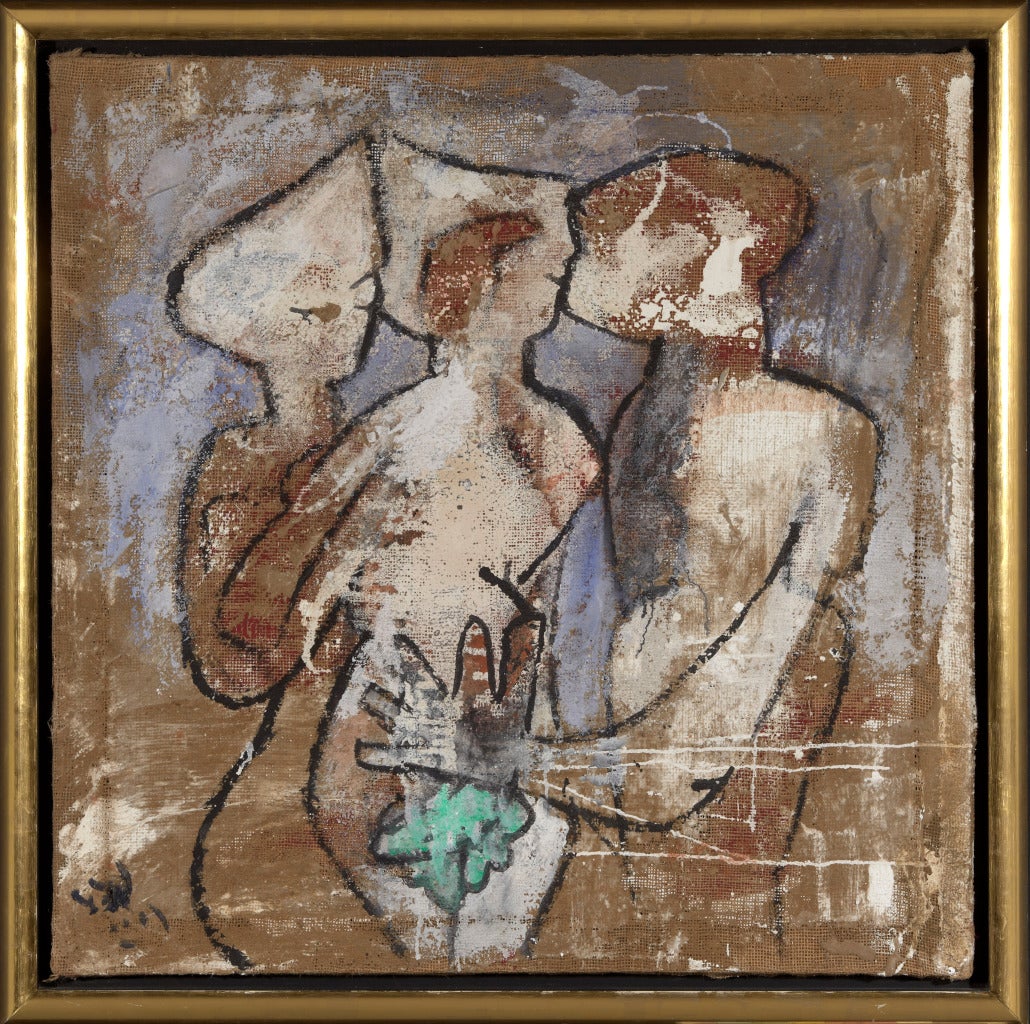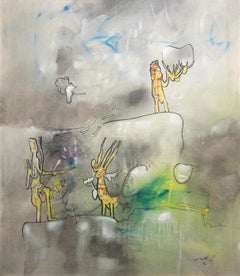Questions & Answers
Our trusted network of 1stDibs sellers answer common questions
What type of art did Roberto Matta do?
1 Answer

Roberto Matta is a painter who became a noted part of the Surrealist movement. Born Roberto Antonio Sebastian Matta Echaurren in 1922 in Santiago, Chile, the artist began his professional life as an architect and slowly switched to painting. His work often featured complex biomorphic forms in disturbing settings, making him an important influence in the post World War II era. Shop a selection of Roberto Matta pieces from some of the world’s top art dealers on 1stDibs.
1stDibs ExpertApril 5, 2022
Related Questions
- What kind of art did Roberto Matta do?1 Answer
- Who is the artist Matta?1 Answer
- Who is Roberto Coin?1 Answer
- Where was Roberto Cavalli from?1 Answer
- How do I pronounce Roberto Cavalli?1 Answer
Shop for Roberto Matta Paintings on 1stDibs
LA DEMONSTRATION (TITRE AU DOS)
By Roberto Matta
Located in Aventura, FL
Original oil on canvas painting. Hand signed, titled and dated on verso by Roberto Matta. Frame size approx 38 x 46 inches.
Artwork is in excellent condition. Certificate of A...
Category
1950s Contemporary Abstract Paintings
Materials
Canvas, Oil
Les travailleurs de la mère
By Roberto Matta
Located in Malmo, SE
Artwork size: 102,5x98 cm
Frame size: 110x105 cm
This artwork is accompanied by a certificate of authenticity signed by Alisée Matta.
Provenance: Artist Jean-Pierre Jouffroy, Paris.
The estate of the artist Jean-Pierre Jouffroy, Paris.
“The heart is an eye,” writes Nobel laureate Octavio Paz in an essay on Matta’s paintings. Matta creates a world coloured both by a sunny faith in the future and by visions of impending doom.
Roberto Sebastian Echaurren Antonio Matta, who died aged 91 on 23 November 2002, was born in Santiago, Chile, on 11 November 1911 into a family with Spanish, French and Basque roots, and raised in an atmosphere of religiosity. By the age of 21 he had graduated and begun work as an architect, but his leisure time he devoted to sketching and painting. In 1933 he travelled to Europe for the first time, visiting Greece, Yugoslavia, Italy and other countries, and subsequently taking the initiative to collaborate with the architect, Le Corbusier. As time passed, however, Matta’s enthusiasm for a career in architecture waned, and he began to devote himself full-time to art, making early acquaintances with surrealists such as Max Ernst, Salvador Dalí, André Breton and others.
Between 1939 and 1948 Matta, like many of his artistic contemporaries, lived in self-imposed exile in the USA, but, after almost 10 years’ absence from Europe, he returned to make first Rome and then, a few years later, Paris his home. Throughout most of the rest of his life Matta commuted between his studio in Paris and his creative refuge in the monastery outside Rome. And it is here, in Italy, that he produced his greatest paintings.
Matta’s first retrospective in Sweden was organised in 1956 when his works were exhibited in what was then Galerie Colibri – run by, among others, the artist C O Hultén...
Category
1980s Surrealist Paintings
Materials
Canvas, Oil
Free Shipping
L'epreuve
By Roberto Matta
Located in Palm Desert, CA
A painting by Roberto Matta. "L'epreuve" is a surrealist painting, oil on canvas in palette of grays, greens, and yellows by Latin American artist Roberto Matta. It is signed in the ...
Category
Mid-20th Century Surrealist Abstract Paintings
Materials
Canvas, Oil
Passage et sage du couple
By Roberto Matta
Located in Paris, FR
Pastel, 1964
Handsigned by the artist in pencil and annotated Essai 1/1
Publisher : Georges Visat (Paris)
Catalog : Sabatier 110
34.00 cm. x 44.50 cm. 13.39 in. x 17.52 in. (paper)
...
Category
1960s Abstract Abstract Paintings
Materials
Pastel
Untitled - Oil on Canvas by Roberto Sebastian Matta - 1996
By Roberto Matta
Located in Roma, IT
Untitled is an original oil on canvas realized by Roberto Sébastian Matta in 1996.
It comes with a certificate of authenticity by Matta's son ...
Category
1990s Surrealist Abstract Paintings
Materials
Canvas, Oil
La vigna di una foglia
By Roberto Matta
Located in Malmo, SE
Technique: Terre colorée sur toile de jute.
Delivered with the certificate of authenticity from the archives of Roberto Matta.
Artwork size: 100 x 100 cm.
Frame size: 114 x 112 cm.
Free shipment worldwide.
Acquired directly from the artist.
“The heart is an eye,” writes Nobel laureate Octavio Paz in an essay on Matta’s paintings. Matta creates a world coloured both by a sunny faith in the future and by visions of impending doom.
Roberto Sebastian Echaurren Antonio Matta, who died aged 91 on 23 November 2002, was born in Santiago, Chile, on 11 November 1911 into a family with Spanish, French and Basque roots, and raised in an atmosphere of religiosity. By the age of 21 he had graduated and begun work as an architect, but his leisure time he devoted to sketching and painting. In 1933 he travelled to Europe for the first time, visiting Greece, Yugoslavia, Italy and other countries, and subsequently taking the initiative to collaborate with the architect, Le Corbusier. As time passed, however, Matta’s enthusiasm for a career in architecture waned, and he began to devote himself full-time to art, making early acquaintances with surrealists such as Max Ernst, Salvador Dalí, André Breton and others.
Between 1939 and 1948 Matta, like many of his artistic contemporaries, lived in self-imposed exile in the USA, but, after almost 10 years’ absence from Europe, he returned to make first Rome and then, a few years later, Paris his home. Throughout most of the rest of his life Matta commuted between his studio in Paris and his creative refuge in the monastery outside Rome. And it is here, in Italy, that he produced his greatest paintings.
Matta’s first retrospective in Sweden was organised in 1956 when his works were exhibited in what was then Galerie Colibri – run by, among others, the artist C O Hultén at number 36 Södra Förstadsgatan in Malmö, Sweden. This was also the time when Matta began to collaborate with poets and other artists in Sweden. He produced the illustrations for Lasse Söderberg’s first anthology of poems, Akrobaterna (“The Acrobats”), published in 1955, and was also responsible for the cover of the Swedish art and literary magazine Salamander.
In 1959 the first museum exhibition of Matta’s work in Europe was arranged at the Museum of Modern Art (Moderna Museet) in Stockholm. Held under the aegis of Pontus Hultén, it was entitled “Fifteen Forms of Doubt” and included 15 or so gigantic paintings...
Category
1980s Surrealist Paintings
Materials
Canvas, Mixed Media
Free Shipping


